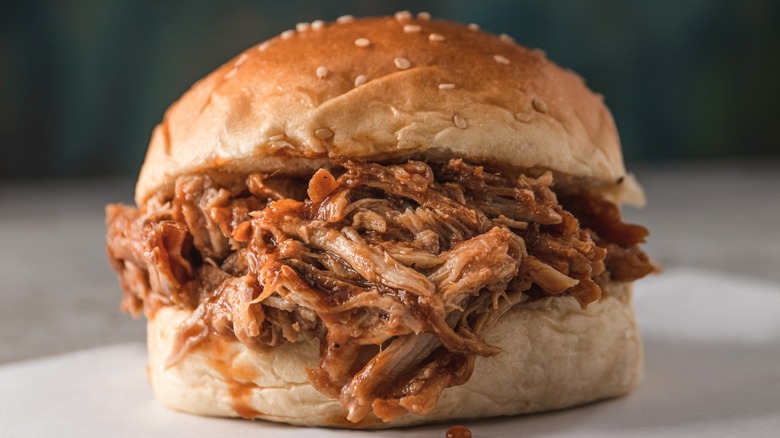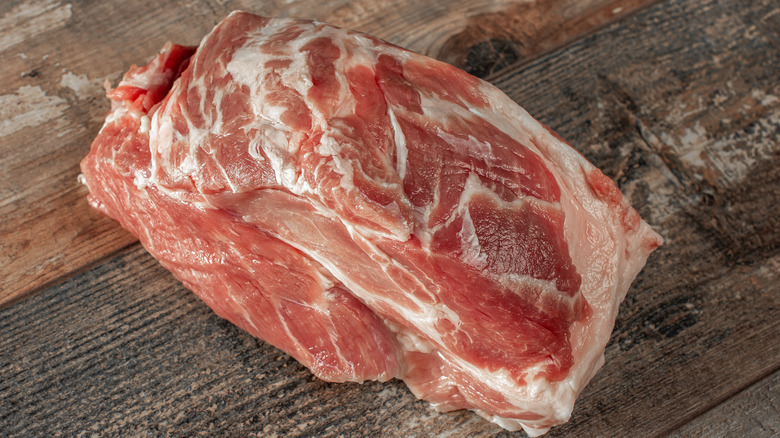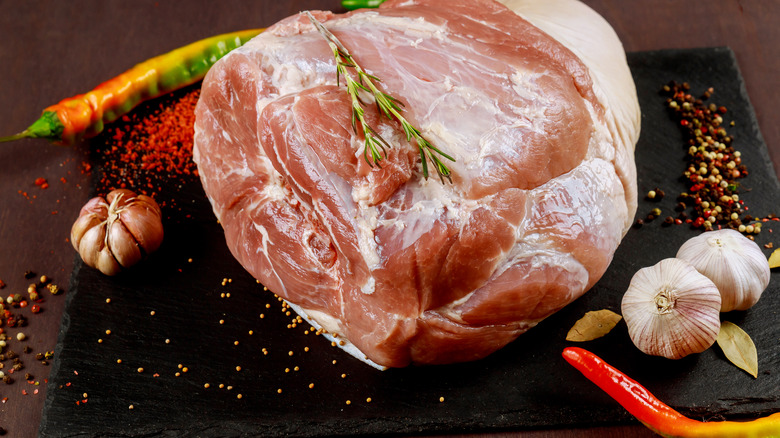When To Use Pork Shoulder Vs Pork Butt For Dinner
Pork butt is a questionable name for a cut of meat. Thankfully, this cut doesn't come from the part of the pig its name suggests. Instead, pork butt is actually taken from a pig's shoulder. You might wonder why we don't call it a "pork shoulder" instead. It certainly seems more desirable than advertising butt in one's food, but there's just one problem here. Pork shoulder is actually a completely different cut of meat. That being said, the two are closely related.
Pork butt and pork shoulder are both cut from the shoulder of the pig's front legs. The butt comprises the top portion of the shoulder, just behind the pig's head, while the pork shoulder is located directly beneath, extending to the start of the leg. It is easy to tell the difference between these two on sight, as pork shoulder is typically sold with the bone in and skin on, while pork butt is a skinless cut that can be sold with or without the bone.
Being from the same general region of the pig, pork butt and pork shoulder have some similar traits. Most importantly, they are hard-working muscles surrounded by lots of fat and connective tissue, and the meat can become tough unless you follow specific cooking methods. However, the best method of using pork butt versus pork shoulder is different depending, and you should be careful about using these cuts interchangeably. For pork shoulder, roasting is ideal, whereas pork butt offers more versatility in that its better for stewing and braising.
Pork butt is the more versatile cut
Pork butt, also known as "Boston butt" is the cut you'll use more often in the kitchen because it is more versatile than pork shoulder. Pork butt is a large, rectangular-shaped cut that typically comes in around six to eight pounds. It is heavily marbled, meaning you'll see white veins of fat streaked all over and through it. Additionally, pork butt is typically sold with a fat cap, a thicker layer of fat covering the broad side of the cut. You can get pork butt with or without the bone in it, but if you're going to cook it whole, you should always opt for bone-in. The bone will impart extra flavor to the meat.
Pork butt has better marbling than pork shoulder, so you should use it for slow-cooking methods where the fat has time to melt into the meat. This should be your go-to cut for stewed and shredded pork dishes, like carnitas, chile verde, or slow cooker pulled pork. Pork butt is also the best choice for making ground pork (which is always best to make fresh at home since ground meat spoils faster than other cuts) because the fat content will keep the meat from drying out. Pork butt is a natural favorite for smoked meat, though with something as slow as barbecue, pork shoulder still works here. Overall, pork butt is more tender and flavorful, so if a recipe gives you the choice between butt and shoulder, choose pork butt.
Use pork shoulder when you want crispy skin
Pork shoulder is also known as "picnic shoulder" or "picnic roast." It is a triangle-shaped cut that ranges from around five to ten pounds in weight, depending on whether you buy it with the bone in or not. It is less common to see boneless pork shoulder, and if you do, it will be wrapped in netting to hold its shape. As with pork butt, it is better to get the bone-in version of this cut if you can because the bone imparts additional flavor while cooking. Notably, pork shoulder is almost always sold with the skin on. The muscles that comprise a pork shoulder play a bigger role in the pig's movement than the muscles in a pork butt, so the meat is tougher. There's also less marbling, so you won't get the added moisture of melting fat. This makes pork shoulder a more challenging cut overall.
The one case where you want to choose pork shoulder over pork butt is if you are making a roast. Thanks to the skin and bone, pork shoulder holds its shape far better than pork butt, even after hours of slow roasting. This allows you to get nice, even slices of meat, whereas pork butt just falls apart. The best part of the pork shoulder is the skin, which gets bubbly and crisp when you roast it, like pork rinds and chicharrones.


